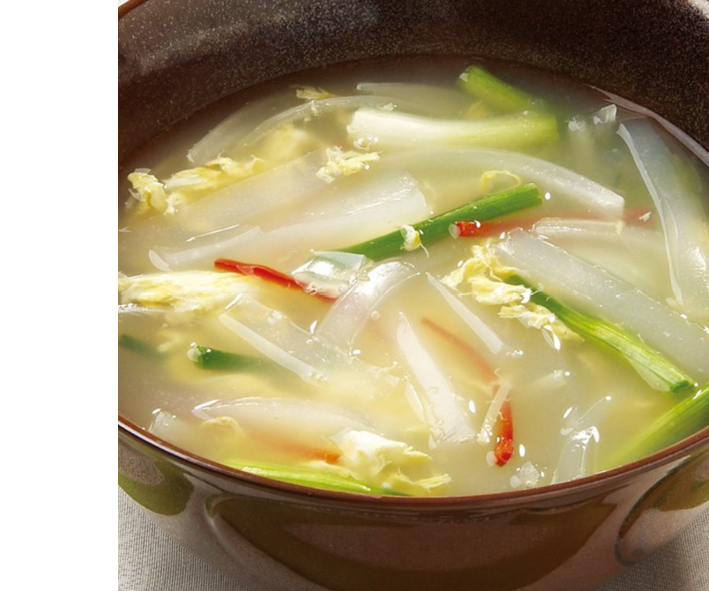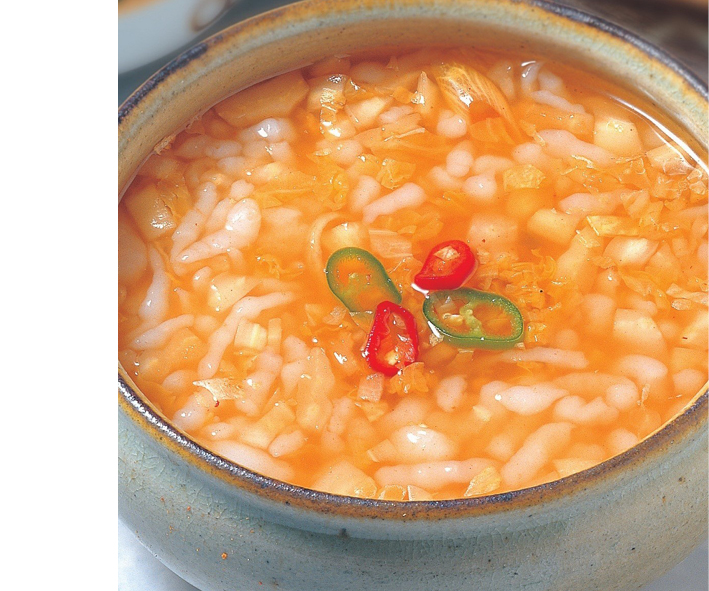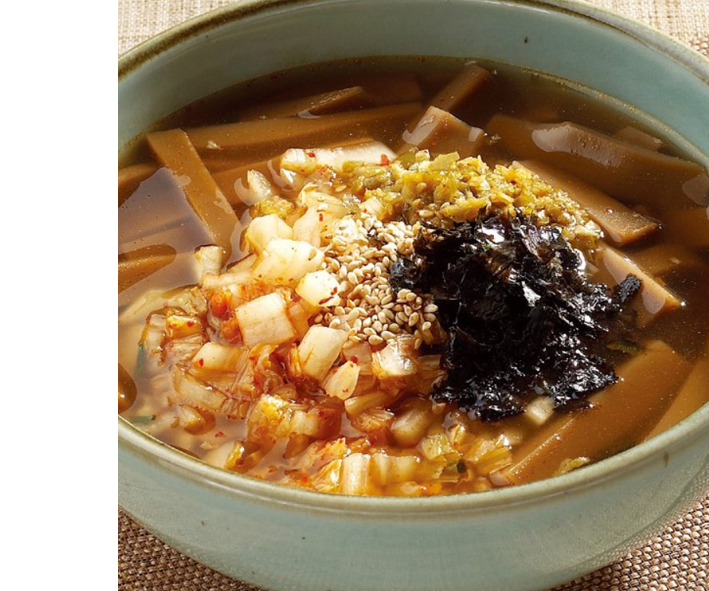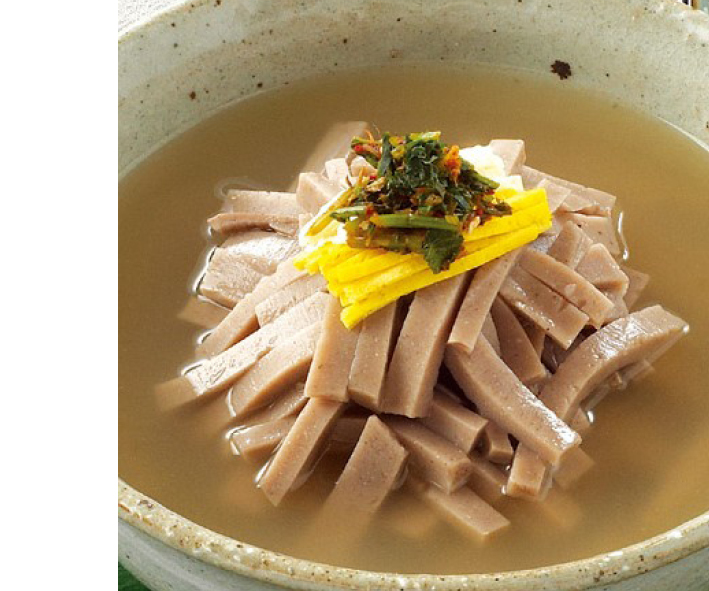한식 읽기 좋은 날
Vol 50. Korean Food, The Culture Blooms
Invitation to Chewy Delicacies Made with Healthy Korean Ingredient “Muk”
New Discovery of Korean Food
Muk(jelly) is a type of food that is unique to Korea, and is made by boiling and hardening the starch of grains or fruits.
It has no specific taste, but its soft texture stimulates the palates, and gives a feeling of satiety when mixed with a variety of vegetables with low calories, so it is a popular diet food. Muk is a seasonal food depending on the main ingredient, so our ancestors prepared an excellent one-dish meal with ingredients suitable for each season.
References. <Traditional Local Food Glossary>(National Academy of Agricultural Sciences, Rural Development Administration, Gyomunsa), <Beautiful Korean Local Food>(Jeong Jaehong et al., Hyungseul Publisher), Rural Development Administration Agricultural Food Olbar
Cheongpomukguk(mung bean jelly soup) filled with flavor and nutrients for the drowsy spring season
Cheongpomuk made with mung bean starch has no specific taste, but it is good as a food ingredient to help recover energy in the spring when you are feeling sluggish. This is because mung beans are rich in essential amino acids and unsaturated fatty acids, helping one to recover from fatigue. It is also rich in dietary fiber, offering satiety and better digestion. Cheongpomukguk is a delicacy that has been eaten frequently in Chungcheong-do since the ancient times. It is characterized by adding cheongpomuk to hot soup, boiling it, and then adding a beaten egg to provide softness.
If you add the crushed laver at the end, its savory taste will be further enhanced.
 Ingredients
Ingredients
300 g cheongpomuk, 20 g dried anchovies(10 pieces), 20 g scallions, 1 red chili, 1/3 onion, 1 egg, 1.3L water, 1 tsp chopped garlic, salt
How to make it
① Chop the cheongpomuk thickly, and blanch it in boiling water to make it transparent.
② Soak the prepared anchovies in water, and drain.
③ Put the soaked anchovies in a pot and stir-fry, then pour water and boil to make anchovy soup.
④ Cut the scallions into 2-cm lengths, and cut the onion and red chili into strips.
⑤ Beat the egg.
⑥ Add the blanched cheongpomuk to the anchovy soup that has a full flavor of anchovy, and boil with onion, scallions, red chilis, and chopped garlic.
⑦ When it comes to a boil, pour in the beaten egg, and season with salt.
Olchaengimukguksu, a bowl of nuttiness that soothes the summer heat
Olchaengimuk(corn starch noodles) is a local dish of Gangwon-do, where plenty of corn is produced. If you grind green corn, boil it thickly, put it in a gourd with holes, and drop it in cold water, it will naturally coagulate, and the head will be round and the tail will remain long, giving it the shape of a tadpole. If you add various seasonings to olchaengimuk sweetened with starch syrup, it will be a good snack to revive the palate you have lost due to the heat.
 Ingredients
Ingredients
5 cups dried corn(3 cups cornstarch), 1 tbsp starch syrup
Sub-ingredients: Sauce(2 tbsp soy sauce, 1 tbsp red chili powder, 1 tbsp chopped green onion, 1/2 tbsp chopped garlic, 1 tbsp sesame salt, 1 tbsp sesame oil, 1/2 chopped green chili pepper, 1/2 chopped red chili)
How to make it
① Soak dried corn in boiling water, then add water to the blender and grind finely.
② Submerge ①, pour out the top water, put the remainder in a pot, boil over medium heat, and make porridge.
③ When it boils, keep stirring and add starch syrup at the end.
④ Put it in a gourd with holes, and place a bowl of cold water under it to let the muk fall down.
⑤ Season olchaengyimuk with the sauce to serve.
Dotorimukbap(chilled acorn jelly and rice soup), a nutty delicacy found in autumn
Acorns have a long history with our people. Acorns, which have been eaten since the Neolithic Age, are fruits that have been in the spotlight as a relief food in times of famine. There is a record in <Goryeosa: The History of Goryeo> that King Chungseon reduced the number of side dishes, and tasted acorns in consideration of the people when there was a famine. When you pour the broth into dotorimuk(acorn jelly) with a subtle bitter taste and soft texture, and add rice, you will taste its full nuttiness.
 Ingredients
Ingredients
250 g acorn jelly, 100 g cabbage kimchi, 20 g fermented chili pepper, 1 sheet laver, 1 tbsp sesame seeds
Sub-ingredients: Broth(1 dried pollack head, 1 green onion, 2 garlic cloves, 1 dry red chilis, 1 kelp, salt, 1L water) Sauce(3 tbsp soy sauce, 1 tbsp chopped green onion, 1 tsp minced garlic, 1tsp red chili powder, 1 tsp sesame oil)
How to make it
① Put the broth ingredients in a pot, pour water, and boil for at least 1 hour.
② When the broth is ready in milky color, sift it through a sieve, and season it with salt.
③ Slice the acorn jelly into thick slices and blanch in boiling water.
④ Shake off the kimchi seasoning, and cut it into small pieces.
⑤ Make the sauce by adding chopped green onion, chopped garlic, red chili powder, and sesame oil to soy sauce.
⑥ Season the dotorimuk with the sauce, put it in a bowl, pour the broth, put kimchi and grilled laver on top, and sprinkle with sesame seeds. Add the rice to the bowl according to the eater’s preference, and serve.
Memilmukguksu(buckwheat jelly noodles), a late-night snack that was popular on a winter night
Memilmukguksu, which is made by pouring a warm broth over thickly sliced buckwheat jellies, and topping with beef, kimchi, and egg garnishes, was our people’s late-night snack that could soothe hunger on a cold winter night. The warm soup warms the whole body, and the soft texture of buckwheat jelly fills the stomach without burden, so it must have been a type of food that comes to mind on winter nights.
 Ingredients
Ingredients
400 g buckwheat jelly, 150 g aged kimchi, 1 sheet laver, 800 ml anchovy broth
Sub-ingredients: Sauce(2 tbsp soy sauce, 2 tbsp chopped green onion, 1 tbsp chopped garlic, 1/2 tsp sesame oil, 1 tbsp sesame salt)
How to make it
① Cut the buckwheat jelly into thick slices, and prepare the aged kimchi by slicing it into small pieces.
② Lightly grill the laver and cut it to the same length as the buckwheat jelly.
③ Add the sauce to the buckwheat jelly, mix lightly, pour in the anchovy broth, and top with the aged kimchi and laver.

 한국어
한국어
 English
English






